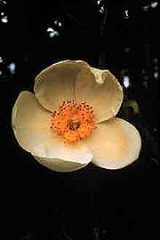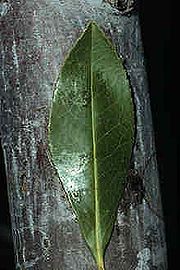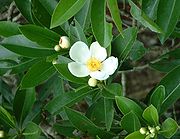
Gordonia
Encyclopedia


Genus
In biology, a genus is a low-level taxonomic rank used in the biological classification of living and fossil organisms, which is an example of definition by genus and differentia...
of flowering plant
Flowering plant
The flowering plants , also known as Angiospermae or Magnoliophyta, are the most diverse group of land plants. Angiosperms are seed-producing plants like the gymnosperms and can be distinguished from the gymnosperms by a series of synapomorphies...
s in the family Theaceae
Theaceae
The Theaceae is a family of flowering plants, composed of shrubs and trees. Some botanists include the family Ternstroemiaceae within the Theaceae while others do not...
, related to Franklinia
Franklinia
Franklinia is a monotypic genus in the tea plant family, Theaceae. The sole species in this genus is a flowering tree, Franklinia alatamaha, commonly called the Franklin tree, and native to the Altamaha River valley in Georgia in the southeastern United States...
, Camellia
Camellia
Camellia, the camellias, is a genus of flowering plants in the family Theaceae. They are found in eastern and southern Asia, from the Himalaya east to Korea and Indonesia. There are 100–250 described species, with some controversy over the exact number...
and Stewartia. Of the roughly 40 species, all but two are native to southeast Asia
Asia
Asia is the world's largest and most populous continent, located primarily in the eastern and northern hemispheres. It covers 8.7% of the Earth's total surface area and with approximately 3.879 billion people, it hosts 60% of the world's current human population...
in southern China
China
Chinese civilization may refer to:* China for more general discussion of the country.* Chinese culture* Greater China, the transnational community of ethnic Chinese.* History of China* Sinosphere, the area historically affected by Chinese culture...
, Taiwan
Taiwan
Taiwan , also known, especially in the past, as Formosa , is the largest island of the same-named island group of East Asia in the western Pacific Ocean and located off the southeastern coast of mainland China. The island forms over 99% of the current territory of the Republic of China following...
and Indochina
Indochina
The Indochinese peninsula, is a region in Southeast Asia. It lies roughly southwest of China, and east of India. The name has its origins in the French, Indochine, as a combination of the names of "China" and "India", and was adopted when French colonizers in Vietnam began expanding their territory...
. The remaining species, G. lasianthus (Loblolly-bay
Loblolly-bay
Loblolly-bay or Gordonia lasianthus is a member of the Tea or Theaceae family.Loblolly-bay , also called holly-bay, gordonia, and bay, is a small to medium-sized evergreen tree or shrub found in acid, swampy soils of pinelands and bays on the Atlantic and Gulf Coastal Plains...
), is native to southeast North America
North America
North America is a continent wholly within the Northern Hemisphere and almost wholly within the Western Hemisphere. It is also considered a northern subcontinent of the Americas...
, from Virginia
Virginia
The Commonwealth of Virginia , is a U.S. state on the Atlantic Coast of the Southern United States. Virginia is nicknamed the "Old Dominion" and sometimes the "Mother of Presidents" after the eight U.S. presidents born there...
south to Florida
Florida
Florida is a state in the southeastern United States, located on the nation's Atlantic and Gulf coasts. It is bordered to the west by the Gulf of Mexico, to the north by Alabama and Georgia and to the east by the Atlantic Ocean. With a population of 18,801,310 as measured by the 2010 census, it...
and west to Louisiana
Louisiana
Louisiana is a state located in the southern region of the United States of America. Its capital is Baton Rouge and largest city is New Orleans. Louisiana is the only state in the U.S. with political subdivisions termed parishes, which are local governments equivalent to counties...
; G. fruticosa is native to the tropical rainforests of Central and South America, from Costa Rica to Brazil.
They are evergreen
Evergreen
In botany, an evergreen plant is a plant that has leaves in all seasons. This contrasts with deciduous plants, which completely lose their foliage during the winter or dry season.There are many different kinds of evergreen plants, both trees and shrubs...
tree
Tree
A tree is a perennial woody plant. It is most often defined as a woody plant that has many secondary branches supported clear of the ground on a single main stem or trunk with clear apical dominance. A minimum height specification at maturity is cited by some authors, varying from 3 m to...
s, growing to 10–20 m tall. The bark
Bark
Bark is the outermost layers of stems and roots of woody plants. Plants with bark include trees, woody vines and shrubs. Bark refers to all the tissues outside of the vascular cambium and is a nontechnical term. It overlays the wood and consists of the inner bark and the outer bark. The inner...
is thick and deeply fissured. The leaves
Leaf
A leaf is an organ of a vascular plant, as defined in botanical terms, and in particular in plant morphology. Foliage is a mass noun that refers to leaves as a feature of plants....
are alternately arranged, simple, serrated, thick, leathery, glossy, and 6–18 cm long. The flower
Flower
A flower, sometimes known as a bloom or blossom, is the reproductive structure found in flowering plants . The biological function of a flower is to effect reproduction, usually by providing a mechanism for the union of sperm with eggs...
s are large and conspicuous, 4–15 cm diameter, with 5 (occasionally 6-8) white petals; flowering is in late winter or early spring. The fruit
Fruit
In broad terms, a fruit is a structure of a plant that contains its seeds.The term has different meanings dependent on context. In non-technical usage, such as food preparation, fruit normally means the fleshy seed-associated structures of certain plants that are sweet and edible in the raw state,...
is a dry five-valved capsule, with 1-4 seed
Seed
A seed is a small embryonic plant enclosed in a covering called the seed coat, usually with some stored food. It is the product of the ripened ovule of gymnosperm and angiosperm plants which occurs after fertilization and some growth within the mother plant...
s in each section.
The species are adapted to acid
Acid
An acid is a substance which reacts with a base. Commonly, acids can be identified as tasting sour, reacting with metals such as calcium, and bases like sodium carbonate. Aqueous acids have a pH of less than 7, where an acid of lower pH is typically stronger, and turn blue litmus paper red...
ic soil
Soil
Soil is a natural body consisting of layers of mineral constituents of variable thicknesses, which differ from the parent materials in their morphological, physical, chemical, and mineralogical characteristics...
s, and do not grow well on chalk
Chalk
Chalk is a soft, white, porous sedimentary rock, a form of limestone composed of the mineral calcite. Calcite is calcium carbonate or CaCO3. It forms under reasonably deep marine conditions from the gradual accumulation of minute calcite plates shed from micro-organisms called coccolithophores....
or other calcium
Calcium
Calcium is the chemical element with the symbol Ca and atomic number 20. It has an atomic mass of 40.078 amu. Calcium is a soft gray alkaline earth metal, and is the fifth-most-abundant element by mass in the Earth's crust...
-rich soils. They also have a high rain
Rain
Rain is liquid precipitation, as opposed to non-liquid kinds of precipitation such as snow, hail and sleet. Rain requires the presence of a thick layer of the atmosphere to have temperatures above the melting point of water near and above the Earth's surface...
fall requirement and will not tolerate drought
Drought
A drought is an extended period of months or years when a region notes a deficiency in its water supply. Generally, this occurs when a region receives consistently below average precipitation. It can have a substantial impact on the ecosystem and agriculture of the affected region...
.
Some botanists include Franklinia within Gordonia, even though recent phylogenetic studies show that Franklinias closest living relationship is with the Asian genera Schima
Schima
[[Schima is a [[genus]] of evergreen trees belonging to the tea family, [[Theaceae]].The genus inhabits warm temperate to subtropical climates across southern and southeastern Asia, from the eastern [[Himalaya]] of [[Nepal]] and eastern [[India]] across [[Indochina]], southern [[China]],...
and not Gordonia; it differs in being deciduous
Deciduous
Deciduous means "falling off at maturity" or "tending to fall off", and is typically used in reference to trees or shrubs that lose their leaves seasonally, and to the shedding of other plant structures such as petals after flowering or fruit when ripe...
and flowering in late summer, not late winter. The draft Flora of China account of Theaceae in China splits Gordonia into two genera, with G. lasianthus retained in Gordonia, and the Asian species transferred to Polyspora; this treatment is not yet widely accepted.
Gordonia chrysandra may have anti-inflamatory medicinal properties.
Species
There are about 40 species, including:- Gordonia anomala
- Gordonia balansae
- Gordonia curtyanaGordonia curtyanaGordonia curtyana is a species of plant in the Theaceae family. It is endemic to Cuba. It is threatened by habitat loss.-Source:* Areces-Mallea, A.E. 1998. . Downloaded on 21 August 2007....
- Gordonia fruticosa
- Gordonia hirta
- Gordonia hirtellaGordonia hirtellaGordonia hirtella is a species of plant in the Theaceae family. It is endemic to Malaysia. It is threatened by habitat loss.-Source:* Chua, L.S.L. 1998. . Downloaded on 21 August 2007....
- Gordonia javanica
- Gordonia lasianthus
- Gordonia maingayiGordonia maingayiGordonia maingayi is a species of plant in the Theaceae family. It is endemic to Malaysia. It is threatened by habitat loss.-Source:* Chua, L.S.L. 1998. . Downloaded on 21 August 2007....
- Gordonia multinervisGordonia multinervisGordonia multinervis is a species of plant in the Theaceae family. It is found in Malaysia and Singapore. It is threatened by habitat loss.-Source:* Chua, L.S.L. 1998. . Downloaded on 21 August 2007....
- Gordonia penangensisGordonia penangensisGordonia penangensis is a species of plant in the Theaceae family. It is found in Malaysia and Singapore. It is threatened by habitat loss.-Source:* Chua, L.S.L. 1998. . Downloaded on 21 August 2007....
- Gordonia scortechiniiGordonia scortechiniiGordonia scortechinii is a species of plant in the Theaceae family. It is endemic to Malaysia. It is threatened by habitat loss.-Source:* Chua, L.S.L. 1998. . Downloaded on 21 August 2007....
- Gordonia shimidae
- Gordonia sinensis
- Gordonia singaporeanaGordonia singaporeanaGordonia singaporeana is a species of plant in the Theaceae family. It is found in Malaysia and Singapore. It is threatened by habitat loss.-Source:* Chua, L.S.L. 1998. . Downloaded on 21 August 2007....
- Gordonia tagawae
- Gordonia taipingensisGordonia taipingensisGordonia taipingensis is a species of plant in the Theaceae family. It is endemic to Malaysia. It is threatened by habitat loss.-Source:* Chua, L.S.L. 1998. . Downloaded on 21 August 2007....
- Gordonia villosaGordonia villosaGordonia villosa is a species of plant in the Theaceae family. It is endemic to Jamaica.-Source:* Bellingham, P. 1998. . Downloaded on 21 August 2007....
- Gordonia wallichii
- Gordonia yunnanensis
Gordonia species from East Asia
East Asia
East Asia or Eastern Asia is a subregion of Asia that can be defined in either geographical or cultural terms...
were transferred to Polyspora, including:
- Polyspora acuminata
- Polyspora axillaris
- Polyspora chrysandra
- Polyspora hainanensis
- Polyspora kwangsiensis
- Polyspora longicarpa
- Polyspora tiantangensis
- Polyspora tonkinensis

